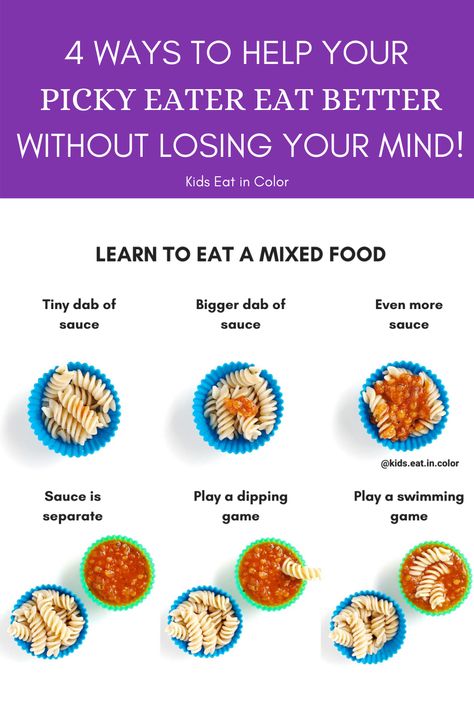What to do if your baby chokes on food
First aid for a baby who is choking
Common questions about first aid for a baby who is choking
What can a baby choke on?
How hard should the back blows be?
Why do I have to hold a baby with its head lower than its bottom?
Why do I have to support the head?
Can I do abdominal thrusts (Heimlich manoeuvre) on a baby?
Should I try to pull the object out with my fingers?
What should I do if a baby becomes unresponsive and stops breathing?
If a baby is choking, should I hold them upside down by their feet?
How do I help a child who is choking?
How do I help an adult who is choking?
What can a baby choke on?
Newborn babies can choke on things like curdled milk, mucus or vomit. As they get older, they move on to solids and explore by putting things into their mouth. This means food or small toys can easily get stuck in their throat, stopping them from breathing.
Back to questions
How hard should the back blows be?
You should change the force of the back blows depending on the size of the baby: be gentler with a smaller baby than with a larger baby. The force you use to deliver the back blows should also be relative to your own strength. The back blows need to be hard enough to cause a vibration in the airway and dislodge the blockage.
Back to questions
Why do I have to hold a baby with its head lower than its bottom?
Babies commonly choke on liquid (mucus or curdled milk), so keeping their head lower than their bottom helps the liquid to drain out – gravity will help.
Back to questions
Why do I have to support the head?
Supporting the head will help to keep the baby’s airway open, helping to dislodge the blockage from the airway.
Back to questions
Can I do abdominal thrusts (Heimlich manoeuvre) on a baby?
No, don’t squeeze a baby’s tummy.
Abdominal thrusts are used to help choking children and adults only. Using abdominal thrusts on a baby could damage their internal organs, which are fragile and still developing.
If back blows do not dislodge the blockage, you should use chest thrusts instead.
Back to questions
Should I try to pull the object out with my fingers?
Do not put your fingers into their mouth if you cannot see an object. You risk pushing any blockage further down or damaging the back of the throat, which could swell and cause further harm.
However, if you can clearly see an object in a baby's mouth and you are able to pluck it out safely with your fingertips, you could do so.
Back to questions
What should I do if a baby becomes unresponsive and stops breathing?
Find out how to help a baby who is unresponsive and not breathing.
Back to questions
If a baby is choking, should I hold them upside down by their feet?
No. This is not effective. You may cause further injury if you happen to drop them. The action of tipping them upside down may also move the blockage further down their throat.
This is not effective. You may cause further injury if you happen to drop them. The action of tipping them upside down may also move the blockage further down their throat.
Back to questions
How do I help a child who is choking?
Find out how to help a child who is choking.
Back to questions
How do I help an adult who is choking?
Find out how to help an adult who is choking.
Back to questions
Email us if you have any other questions about first aid for a baby who is choking.
infant under 1 year: MedlinePlus Medical Encyclopedia
URL of this page: //medlineplus.gov/ency/article/000048.htm
To use the sharing features on this page, please enable JavaScript.
Choking is when someone cannot breathe because food, a toy, or other object is blocking the throat or windpipe (airway).
This article discusses choking in infants.
Choking in infants is usually caused by breathing in a small object that the baby has placed in their mouth, such as a button, coin, balloon, toy part, or watch battery.
Choking may result from a complete or partial blockage of the airway.
- A complete blockage is a medical emergency.
- A partial blockage can quickly become life threatening if the baby cannot get enough air.
When a person does not get enough air, permanent brain damage can occur in as little as 4 minutes. Rapid first aid for choking can save a life.
The danger signs of choking are:
- Bluish skin color
- Difficulty breathing -- ribs and chest pull inward
- Loss of consciousness (unresponsiveness) if blockage is not cleared
- Inability to cry or make much sound
- Weak, ineffective coughing
- Soft or high-pitched sounds while inhaling
DO NOT perform these steps if the infant is coughing hard or has a strong cry. Strong coughs and cries can help push the object out of the airway.
Strong coughs and cries can help push the object out of the airway.
If your child is not coughing forcefully or does not have a strong cry, follow these steps:
- Lay the infant face down, along your forearm. Use your thigh or lap for support. Hold the infant's chest in your hand and the jaw with your fingers. Point the infant's head downward, lower than the body.
- Give up to 5 quick, forceful blows between the infant's shoulder blades. Use the palm of your free hand.
If the object does not come out of the airway after 5 blows:
- Turn the infant face-up. Use your thigh or lap for support. Support the head.
- Place 2 fingers on the middle of the breastbone just below the nipples.
- Give up to 5 quick thrusts down, compressing the chest one third to one half the depth of the chest.
- Continue 5 back blows followed by 5 chest thrusts until the object is dislodged or the infant loses alertness (becomes unconscious).
IF THE INFANT LOSES ALERTNESS
If the child becomes unresponsive, stops breathing, or turns blue:
- Shout for help.

- Give infant CPR. Call 911 or the local emergency number after 1 minute of CPR.
- If you can see the object blocking the airway, try to remove it with your finger. Try to remove an object only if you can see it.
- DO NOT perform choking first aid if the infant is coughing forcefully, has a strong cry, or is breathing enough. However, be ready to act if the symptoms get worse.
- DO NOT try to grasp and pull out the object if the infant is alert (conscious).
- DO NOT do back blows and chest thrusts if the infant stops breathing for other reasons, such as asthma, infection, swelling, or a blow to the head. Do give the infant CPR in these cases.
If an infant is choking:
- Tell someone to call 911 or the local emergency number while you begin first aid.
- If you are alone, shout for help and begin first aid.
Always call your doctor after a child has been choking, even if you successfully remove the object from the airway and the infant seems fine.
To prevent choking in an infant:
- Do not give children under 3 years old balloons or toys with small parts that can break off.
- Keep infants away from buttons, popcorn, coins, grapes, nuts, and other small items.
- Watch infants and toddlers while they are eating. Do not allow a child to crawl around while eating.
- The earliest safety lesson is "No!"
- Choking first aid - infant under 1 year - series
Atkins DL, de Caen AR, Berger S, et al. 2017 American Heart Association focused update on pediatric basic life support and cardiopulmonary resuscitation quality: an update to the American Heart Association Guidelines for cardiopulmonary resuscitation and emergency cardiovascular care. Circulation. 2018;137(1):e1-e6. PMID: 29114009 pubmed.ncbi.nlm.nih.gov/29114009/.
Rose E. Pediatric respiratory emergencies: upper airway obstruction and infections. In: Walls RM, Hockberger RS, Gausche-Hill M, eds. Rosen's Emergency Medicine: Concepts and Clinical Practice.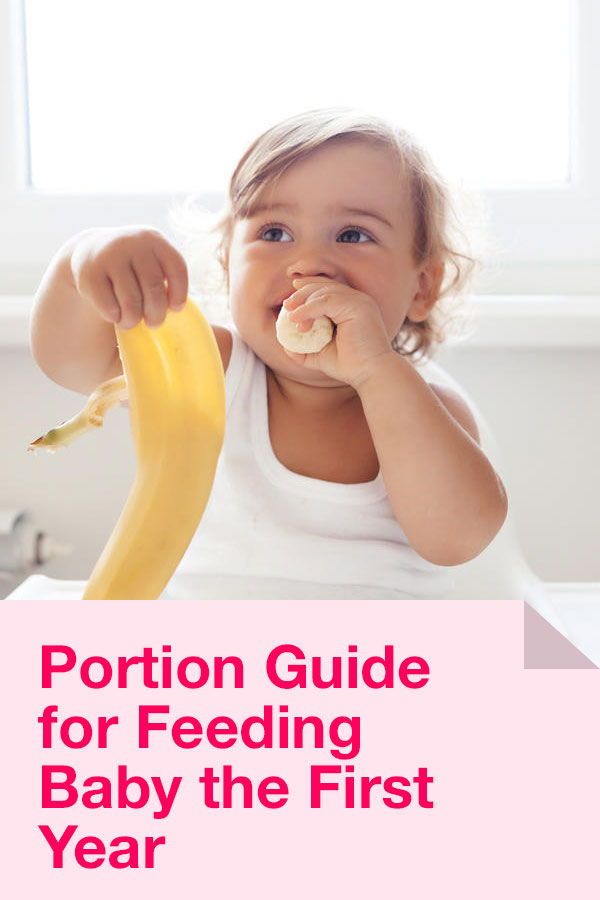 9th ed. Philadelphia, PA: Elsevier; 2018:chap 167.
9th ed. Philadelphia, PA: Elsevier; 2018:chap 167.
Thomas SH, Goodloe JM. Foreign bodies. In: Walls RM, Hockberger RS, Gausche-Hill M, eds. Rosen's Emergency Medicine: Concepts and Clinical Practice. 9th ed. Philadelphia, PA: Elsevier; 2018:chap 53.
Updated by: Jesse Borke, MD, CPE, FAAEM, FACEP, Attending Physician at Kaiser Permanente, Orange County, CA. Also reviewed by David Zieve, MD, MHA, Medical Director, Brenda Conaway, Editorial Director, and the A.D.A.M. Editorial team.
What to do if a child chokes
It is impossible to control 100% of all the actions of the baby, therefore, cases when children get something into the respiratory tract or they choke on something often occur. Most often, parents do not need to take any action, because. the child's body is able to independently get rid of a foreign object with the help of a cough. A sign that the airway is not blocked is that the child may cry and/or call for help. Then you just calm the baby and keep the situation under control.
Then you just calm the baby and keep the situation under control.
Signs that intervention is needed?
- eyes wide open in panic
- he cannot utter words, cry and scream, or does it quietly and wheezing
- there is increased salivation
- baby opens mouth wide
- skin turns red and then turns blue
- older children may hold their throats
- loss of consciousness
The first thing to do is to call an ambulance. It is advisable to have someone else do this so that you can immediately begin to provide first aid.
First aid for children under one year old
As a rule, infants choke while eating or drinking due to incorrect posture.
Your possible actions:
1. Raise the baby's hands up. Despite its unusualness and simplicity, this method helps to normalize the breathing process by expanding the airways.
2. Put the child on your hand with your stomach down and make five pats between the shoulder blades with the edge of your palm.
3. In the case when the baby choked on a small object, it is necessary by the child's legs so that the head is down and also pat between the shoulder blades
4. Tilt the body of the child down, press on the root of the tongue, thereby causing vomiting.
5. If the baby choked on the liquid and began to cough, choke with a cough, breathe noisily, and also in case of a solid object getting stuck, it is necessary to turn it with its back to you, hug your hand while pressing it on the stomach area, tilt the child forward and pat on the back, as described in the first paragraph.
If there are no signs of improvement, lay him on his back so that his head is lower than his torso. Place your middle and index fingers under your baby's breastbone. Do five pressures to a depth of 1-2 cm, making sure that after each of them the baby's sternum straightens without removing the fingers. You should alternate pressure and pats on the back until the doctors arrive. After each pop, check to see if the airway blockage has been cleared.
After each pop, check to see if the airway blockage has been cleared.
Attention! All pressing and patting should be gentle but sharp!
You can find on the Internet a recommendation to check the child's larynx with your finger and, if possible, remove the stuck object. Such advice is useful if the foreign object is something soft, such as cotton wool. In other cases, there is a great risk of aggravating the situation by accidentally moving the subject even further.
First aid for a child older than one year
Remain calm so as not to aggravate the child's panic.
You can use the above methods for older children as well. 5 point will differ by the posture of the child. See picture below:
Also for children aged from a year (in no case for children younger!) The Helmich method is effective. The sequence of your actions will be as follows:
- stand behind the baby, you can kneel if his height is still small
- clench the hand of one hand into a fist and place the thumb inside between the ribs and the navel of the child
- clasp the fist with the palm of the other hand
- spread your elbows to the sides and press on the child's stomach from the bottom up
- continue until the foreign object is out of the respiratory tract
If the child's breathing has stopped
If the child's breathing stops during removal of the foreign body and does not resume after removal, this may be the result of a spasm in the throat due to stress. Breathing resumption method:
Breathing resumption method:
- lay the child on its side on a flat hard surface
- tilt head back a little
- lift chin
If the attempt was unsuccessful, it is urgent to start performing artificial respiration and chest compressions. How to do this can be read, for example, here.
Even if you managed to solve the problem on your own, you should definitely consult a doctor to check if the baby has damaged the airways.
What should I do if my child chokes?
What to do if the baby is choking? Everyone needs to know this. And if this happened, it is dangerous to waste time, every second counts here. But let's start with what you don't need to do.
Useful and useless measures
The potential danger for the baby is often formed by his mother and father. Teeth are cut, and the baby strives to gnaw on all the objects that it can reach. What is the point of giving foreign objects to gnaw - it is much more logical to give the baby something edible, useful. For example, a piece of banana, apple or cucumber. This is the point of view of some parents. The child is under supervision - what can threaten him? But trouble can happen in the blink of an eye.
For example, a piece of banana, apple or cucumber. This is the point of view of some parents. The child is under supervision - what can threaten him? But trouble can happen in the blink of an eye.
If at least the top of a milk tooth has hatched in a baby, he will certainly bite off at least a small crumb from the fruit. He was delighted, frightened, inhaled sharply - and now the fool choked on food.
Slightly older babies can be harmed by small fragments of toys - because they need to taste everything. Yes, and during a normal meal, a child can form and make a voice, laugh, whimper - and choke. A typical situation is when an ordinary candy becomes the cause of such an incident.
- In other words, in no case do not neglect the age restrictions indicated on the toys;
- the baby should not touch things from which a small part or detail can be separated;
- as early as possible wean him to give voice during meals;
- do not let the baby play or fall asleep with candy in his mouth.
Despite any preventive measures, one should never relax and one must constantly be vigilant. If the baby choked and it became difficult for him to breathe, you can’t hesitate, we begin a set of urgent measures.
Procedure for choking a baby under one year of age:
- you should raise the handles up - thereby expanding the airways a little, it will become easier for the child to inhale and exhale;
- if breathing is not restored, we put the baby face in the palm, lifting his ass a little higher than his head. Slightly patting on the back, successively directing these claps from the pelvic region to the back of the head. Then the child needs to be turned over, and the butt is still above the level of his head, and lightly press on the sternum 4-6 times, trying to force the fluid out of the lungs. These techniques should be repeated until free breathing is fully restored.
- if the reason that the baby choked was food, you should gently lift him up, holding his legs or stimulate the child to vomit by pressing a finger on the root section of his tongue.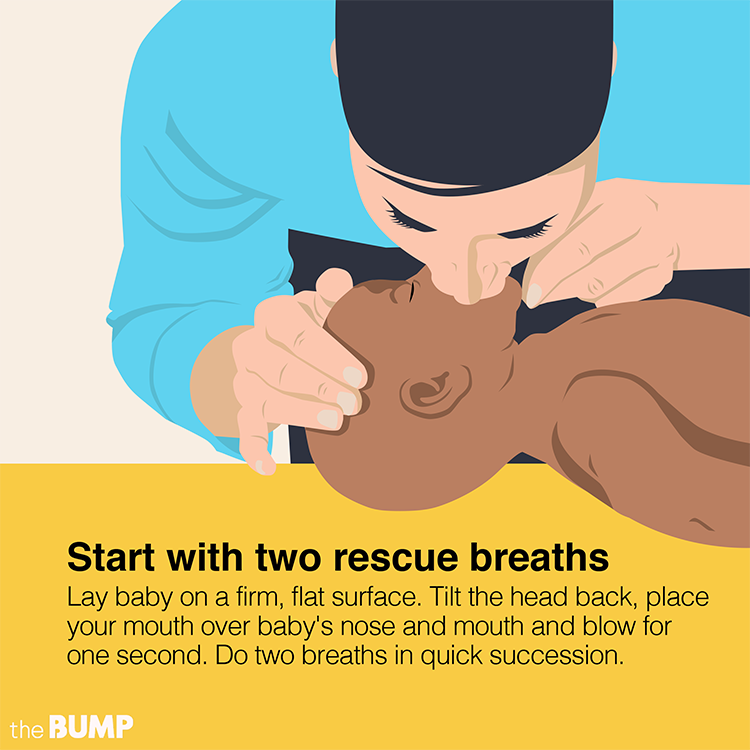
If a foreign object is in the airways, preventing the child from crying and raising a voice, if he waves his arms and pulls in his tummy, immediately call the emergency medical service, before she arrives, you need to do this:
- When the liquid became the cause, the baby has a cough and shortness of breath, take the child with his back to you, hugging and pressing on the tummy near the stomach, tilting the baby, pat him on the back.
- If this does not work, put the baby on the back with his head below the body. Place your middle and index fingers under the baby's breastbone and apply pressure five times. Make sure your chest expands after each press.
- If the cause of the accident was a small solid object (bead, part from the designer), lay the child on his tummy over your arm, placing his head below the torso. With the palm of your other hand, lightly tap on the back. You can also lift the child by the legs to also pat on the back.
- Combine the above techniques, controlling whether the foreign object came out. If you did everything right and this object appeared in your mouth, carefully remove it from there.
If you did everything right and this object appeared in your mouth, carefully remove it from there.
- If these techniques do not give the desired result, artificial respiration should be started. For babies up to 8 months of age, it is done immediately both in the nose and in the mouth. Here you do not need to tilt your head back, just slightly raise the child's chin.
Exhale 3-5 times and make sure the baby's chest expands. If this happens, then the baby can breathe. Take a few more breaths to help the child return to a normal breathing rhythm.
All movements must be done in no way abruptly, without effort. Overdone, you can injure the baby and harm him even more.
What NOT to do when the baby is choking
If this happens, then the most important thing is not to lose your cool and determine whether you need to call emergency medical care. Mom's commotion will frighten the child much more.
For example, choking, the baby retains the ability to breathe in and out. He cries, screams. In this case, you do not need to tap him on the back: let him clear his throat, after which the child needs to be reassured.
He cries, screams. In this case, you do not need to tap him on the back: let him clear his throat, after which the child needs to be reassured.
If a foreign object is in the airways, it is strictly forbidden to pat the child on the back when he is in a vertical position. In this case, it can be harmed by involuntarily pushing a foreign object much deeper. In such a situation, it is necessary to tilt the head and body of the baby.
Remember the strict requirement: in any case, do not try to remove the stuck object on your own! You can make the child much worse, and his breathing can be completely blocked. In this case, you need to call the "ambulance".
Measures to help babies over one year of age
You need to start with one thing: no panic! One-year-old children and older are already well aware and perceive the emotions of their parents. And with your unbridled panic, you can alarm the child too much.
In essence, the measures of immediate assistance to infants of this age category approximately coincide with the methods of assistance to infants.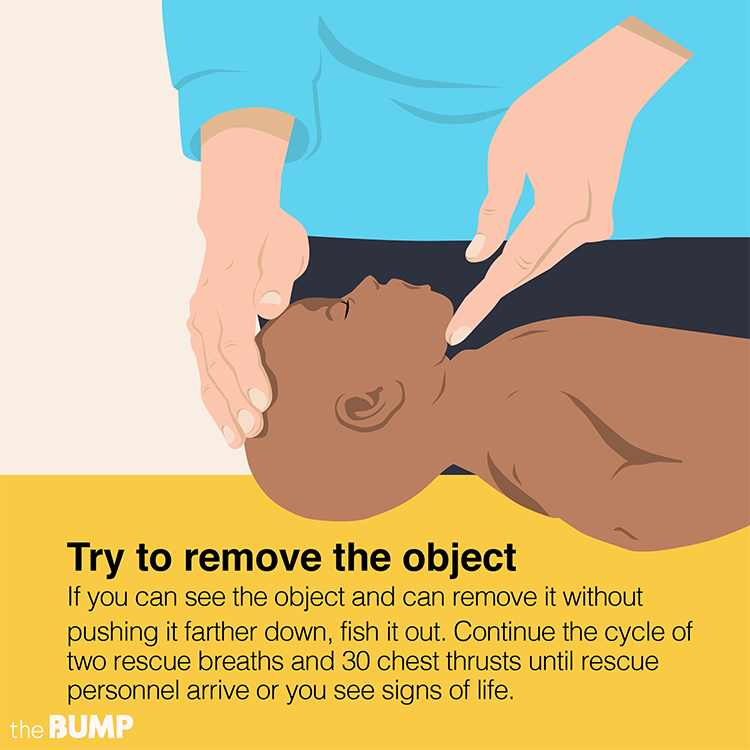 If a foreign object or food crumbs gets into the larynx, lift the baby, firmly grasping the legs, or stimulate his gag reflex. However, in most cases, the child manages to cough without outside help.
If a foreign object or food crumbs gets into the larynx, lift the baby, firmly grasping the legs, or stimulate his gag reflex. However, in most cases, the child manages to cough without outside help.
But if the situation turned out to be more complicated and the above measures did not give the desired result, then the procedure is as follows. You need to put the baby face up on the crib. Press under the ribs into the upper abdomen, pushing up slightly, repeat several times. These movements stimulate the movement of a foreign object back into the oral cavity.
Often another method is used. The child is in front of you, with his back to you. Place your palm on his chest so that the baby rests on your arm. His body should be slightly tilted forward. With the other hand, tap on the back between the shoulder blades 4-5 times.
In the event that a foreign object has become the cause of the accident, it is also recommended to use the direct aid method for suffocation, developed by the American surgeon Henry Heimlich. This technique includes two different ways of helping, depending on whether the patient is conscious or not.
This technique includes two different ways of helping, depending on whether the patient is conscious or not.
First way
Standing behind, clench your right hand into a fist, on top - the left. Press vigorously with the fist of your right hand on the area under the ribs above the navel, directing the movement from the bottom up, towards the sternum, while the arms are bent at the elbows. Continue until then. Until the subject exits and breathes back. This method is suitable for babies from the age of one.
Second way
Lay the child face up and place the hands in the same way as in the first example. With vigorous movements, push up towards the diaphragm until the victim resumes independent inhalations and exhalations. If these efforts fail, artificial respiration and chest compressions may be needed.
These exercises should be done until the foreign object returns to the oral cavity. This method does not apply to babies under 1 year old.
Baby is choking and not breathing: what to do
When the child chokes, it is likely that breathing stops due to spasms in the larynx. The most common cause of them is a stressful situation for the child.
The order of urgent action in such a situation is as follows:
- you need to lay the child sideways on the table;
- slightly tilt your head back;
- slightly raise your head by the chin.
If breathing is not restored, begin artificial respiration immediately:
- in the same way, put the baby on the table;
- take the head back and open your mouth;
- make sure there are no foreign objects in the oral cavity;
- exhale into the child's mouth for a long time;
- repeat 3-4 times. If the chest expands, then you have achieved the desired result, the air enters the lungs of the child. If the baby's chest is immobile, then take urgent measures to eliminate obstructions to breathing;
- after this, we place one palm on top of the other on the child's chest and press sharply - the chest should straighten out each time;
- alternate this massage and exhalation into the mouth at least 16 times.
What to do when the baby chokes
This can happen in various circumstances: bathing in a bathtub, splashing in a summer inflatable pool or in a pond, falling into a pond, or accidentally inhaling liquid while drinking. Measures to save a choked baby must also be taken as quickly as possible:
- Place the baby on your thigh prone, lowering his head below the body, and press on his back. By doing this, you will help eliminate water from his respiratory tract.
- Make sure that there are no foreign objects or vomit in the child's mouth.
- Following this, it is necessary to take measures, according to the basic requirements:
- Respiratory patency should be achieved. The baby lies prone, his neck is not bent, the lower jaw is advanced, the tip of the tongue is retracted. We massage the heart, do artificial respiration.
If we do everything as it should be, then we observe the rhythmic movement of the breathing baby's chest.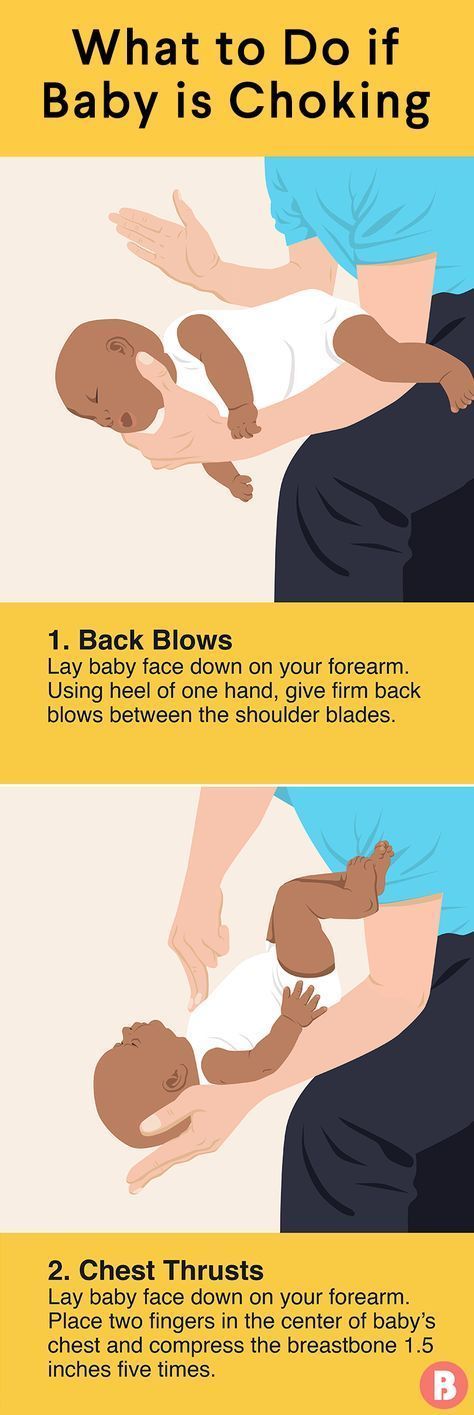 If these regular movements are absent, but the abdomen is swollen, then breathing does not occur.
If these regular movements are absent, but the abdomen is swollen, then breathing does not occur.
For every couple of exhalations, press the chest 15 times. Toddlers up to one year of age should do these movements with two fingers, and only starting from a year old can you use your palm. Pressing forces should be applied on the sternum in the area between the nipples.
Having brought the baby to consciousness, in no case do not refuse his examination in a medical institution. Such an incident may have further undesirable consequences - for example, pulmonary edema within 3 days after the water has entered the respiratory tract.
When your baby accidentally chokes or chokes, you will not have the opportunity to study the advice of professional pediatricians on the Internet for your situation. There won't be a second to lose. Not only health, but often the life of the child will depend on the speed and effectiveness of your measures. And the best thing you can do now for your child is to learn the most important first aid skills in advance so that when faced with an unexpected incident, you do not panic.



